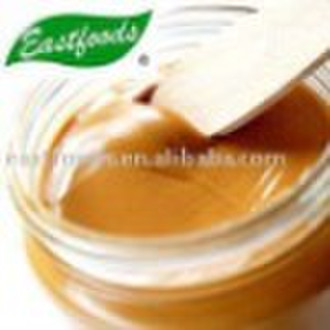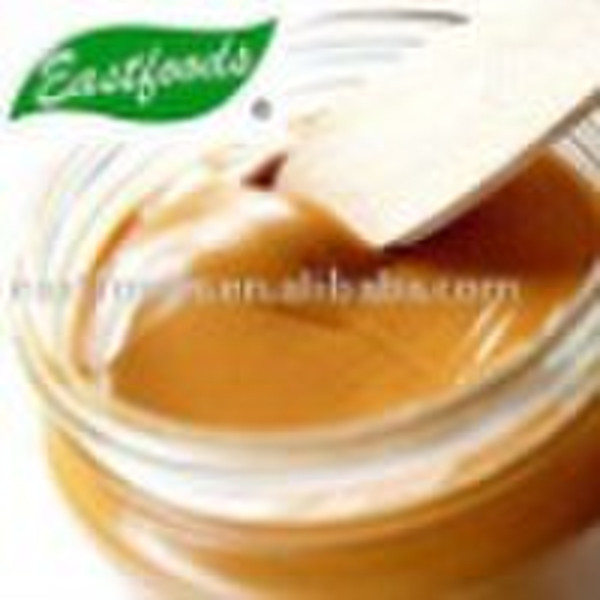花生酱
原价: 1 500 USD
日照街道, 中国

Xin Zheng
联系人姓名
基本信息
PEANUT BUTTER:
Smooth/Creamy, Crunchy, Original type.
Packing:
(1):Packed in 340g X 24 plastic bottles / carton, 1600CTNS / 20'FCL.
(2):Packed in 480g X 24 plastic bottles / carton, 1100CTNS / 20'FCL.
(3):Packed in 510g X 24 plastic bottles / carton, 2000CTNS / 20'FCL.
(4):Packed in 50LB plastics bag / carton, 960CTNS / 20FCL.
Peanut ButterFound in three-fourths of the pantries across the US, peanut butter is truly an American staple. In this country alone, we consume about 700 million pounds of it every year! More than 50% of the peanuts grown are eaten in the form of peanut butter. And why not? Children know it as their favorite sandwich filling, adults use it as a savory addition to sauces and spread, and everyone loves it paired with other indulgences in rich desserts. What began as a simple vegetarian protein alternative, peanut butter has become one of the most affordable, nutritious, and delicious food items available today!Health BenefitsHigh in mono- and polyunsaturated fats, consumption of peanut butter can contribute to improving cholesterol levels and reducing the risk of disease. Peanut butter is also an excellent source of plant protein. With about 8g per 2 Tbsp. of peanut butter, a small serving can make a significant contribution to daily protein intake. Peanut butter is a great substitution or alternative to meat products because it is much less expensive, it is filling, and it contains fiber. Finally, peanut butter is jam-packed with hard-to-get nutrients such as phosphorus, potassium, zinc, folate, and the antioxidant vitamin E. Even phytochemicals – specifically, resveratrol – can be found in peanut butter.Understanding Peanut ButterPeanut butter has been an inexpensive favorite through the life cycle, but recently confusion has arisen concerning the types of peanut butter that we eat – what is the difference between commercial and “natural” peanut butter? And are both types healthy?To be called peanut butter, both commercial and “natural” types must contain a minimum of 90% peanuts, with no artificial sweeteners, colors, or preservatives. This includes the chunky version. Commercial peanut butters are blended or homogenized for convenience and for creaminess, whereas “natural” peanut butters require stirring and are not as smooth in texture.To stabilize commercial peanut butter blends and eliminate separation, manufacturers may add a small amount (less than 1-2%) of partially hydrogenated, or fully hydrogenated oil. For added flavor, some commercial brands may also add small amounts of sugar or salt. Even with these additions, changes in macronutrient content per serving compared to “natural” peanut butter are minimal.PeanutButter:
Product Type and Flavors: (We can supply various flavors according your requirement)
Crunchy
Sugarless
Vanilla
Smooth
Chocolate Crunchy
Classic
Pure Peanut Butter
Salty Peanut Butter
Original Peanut Butter
Size and Packaging: (We can supply various packaging size according your requirement)
200g×12/ctn
5000ctn/20'FCL
340g×12/ctn
3170ctn/20'FCL
510g×12/ctn
2235ctn/20'FCL
1kg×12/ctn
1120ctn/20'FCL
20kg/drum (Pure)
950drum/20'FCL
peanut butter barrel
peanut butter bottle
peanut butter
peanut butter
交货条款及包装
Packaging Detail: (1):Packed in 340g X 24 plastic bottles / carton, 1600CTNS / 20'FCL.(2):Packed in 480g X 24 plastic bottles / carton, 1100CTNS / 20'FCL.(3):Packed in 510g X 24 plastic bottles / carton, 2000CTNS / 20'FCL.(4):Packed in 50LB plastics bag / carton, 960CTNS / 20FCL.
Delivery Detail: 20days
端口: QINGDAO
付款条款
Letter of credit
Telegraphic transfer
-
支付方式
我们接受:









